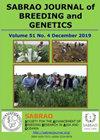COMPARATIVE ASSESSMENT OF GENETIC DIVERSITY BETWEEN BRASSICA NAPUS AND BRASSICA JUNCEA BASED ON PHENOTYPIC TRAITS
IF 1.6
Q3 PLANT SCIENCES
引用次数: 0
Abstract
Rapeseed and mustard crops’ extensive promotion for crop diversification and their potential to favorably respond to breeding programs depends on their existing nature and the magnitude of genetic variability. Therefore, the progressive research sought to estimate the genetic diversity of 40 genotypes of Brassica napus (20) and Brassica juncea (20) based on phenotypic characters. The material, grown in randomized complete block design, had three replications during winter 2020– 2021. The mean square from analysis of variance demonstrated significant differences for all the parameters among examined varieties, indicating that utilized material contained sufficient genetic variability. Regarding average performance, two mustard genotypes, Dhoom-I and Anmol Raya, performed better for seed yield plant-1 and can undergo assessment in upcoming breeding programs for enhancing seed yield. Meanwhile, high heritability occurred in oil content, silique length, 1000-seed index weight, and plant height. Diversity analysis, cluster mean, and total divergence contribution revealed maximum differences for various traits and possessed noteworthy sources for future breeding programs. The magnitude of cluster distance indicated that cluster VI comprised two mustard genotypes (Early Raya and Sindh Raya) and cluster IV consisted of three rapeseed genotypes (Rohi Sarson, hyola-401, and Kn-277), demonstrating that maximum distance is more diverse and helpful for upcoming heterotic recombination. Comparing genetic variation between rapeseed and mustard genotypes showed that rapeseed genotypes displayed more genetic variability in the first three components of PCA than its counterpart, yet expressing that mustard genotypes also have enormous valuable genetic resources. Similarly, genotypes Rohi Sarson, hyola-401, and Kn-277 resulted in the highest genotypic scores in three-dimensional graphs; hence, these genotypes are more diverse and can benefit future hybridization programs.基于表型特征的甘蓝型油菜和芥菜型油菜遗传多样性的比较评价
油菜籽和芥菜作物对作物多样化的广泛促进及其对育种计划的有利响应潜力取决于其现有的性质和遗传变异性的大小。因此,本研究试图基于表型特征估算甘蓝型油菜(20)和芥菜(20)的40个基因型的遗传多样性。该材料采用随机完全区组设计,在2020年至2021年冬季进行了三次重复。方差分析的均方分析表明,各品种间各参数差异显著,说明利用材料具有充分的遗传变异性。在平均性能方面,两种芥菜基因型(dhoom -1和Anmol Raya)在种子产量植株1上表现较好,可以在未来的育种计划中进行评估,以提高种子产量。同时,含油量、角长、千粒重和株高具有较高的遗传力。多样性分析、聚类均值和总散度贡献揭示了各性状间的最大差异,为今后的育种规划提供了重要参考。聚类距离的大小表明,聚类VI由2个芥菜基因型(Early Raya和Sindh Raya)组成,聚类IV由3个油菜籽基因型(Rohi Sarson、hyola-401和Kn-277)组成,表明最大距离具有更大的多样性,有利于未来的杂种重组。比较菜籽和芥菜基因型的遗传变异,发现菜籽基因型在PCA前三个分量上表现出更大的遗传变异性,表明芥菜基因型也具有巨大的宝贵遗传资源。同样,Rohi Sarson基因型、hyola-401基因型和Kn-277基因型在三维图谱上得分最高;因此,这些基因型更加多样化,有利于未来的杂交计划。
本文章由计算机程序翻译,如有差异,请以英文原文为准。
求助全文
约1分钟内获得全文
求助全文
来源期刊

Sabrao Journal of Breeding and Genetics
农林科学-奶制品与动物科学
CiteScore
1.90
自引率
50.00%
发文量
63
期刊介绍:
The SABRAO Journal of Breeding and Genetics is an international journal of plant breeding and genetics research and was first published in 1969. It is the official publication of the Society for the Advancement of Breeding Research in Asia and Oceania (SABRAO).
Its objectives are to: promote the international exchange of research information on plant breeding and genetics, by describing new research findings, or ideas of a basic or practical nature; and be a medium for the exchange of ideas and news regarding members of the Society.
The Journal gives priority to articles that are of direct relevance to plant breeders and with emphasis on the Asian region. Invited for publication are research articles, short communications, methods, reviews, commentaries, and opinion articles. Scientific contributions are refereed and edited to international standards.
The journal publishes articles for SABRAO members mainly. The Journal preferred strongly that at least one author should be a current member of the Society. Non-members may also publish in the journal.
 求助内容:
求助内容: 应助结果提醒方式:
应助结果提醒方式:


